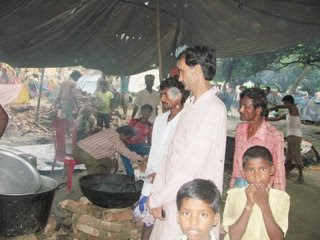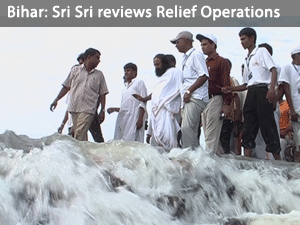.jpg)


Central Water Commission CWC is an apex body of India to look after the
irrigation and flood control in the country. Any trivial matter regarding these two
issues cannot move any further without the nod of this institution. Ask CWC
which year Bihar was hit by the worst floods in the history, the answer would be
2004. This is because, according to CWC, 2004 was the year when 4.99 million
hectares (MH) of land in Bihar was inundated. This information must have been
given to CWC by Government of Bihar GoB. In fact, 2004 flood of Bihar was
limited to 20 districts of North Bihar (Siwan and Saran faced no floods in 2004).
Area of North Bihar is around 5.4 MH and the combined area of Siwan and
Saran is 0.486 MH. Subtract this area from the area of North Bihar to get a
figure of 4.914 MH implying that the flooded area of North Bihar was more than
the actual area of the region. When this anomaly was reported in the press, the
flood hit area of the state slumped down overnight to 2.772 MH in the reports
prepared by Disaster Management Department of the State. GoB, however,
took precaution in retaining the flood affected area as 4.99 MH when it
submitted a memorandum to the Prime Minister for assistance to combat the
losses that year. Even Prime Minister's Office did not notice the fallacy in
reporting and so did Ministry of Water Resources and the CWC. One wonders
that in future if a relationship is drawn between the rainfall, highest flood levels
of the rivers and the area affected due to floods in Bihar, will it not lead to
erroneous conclusion? The answer is - who bothers? That is the seriousness
with which data are handled by these august institutions.
GoB took another precaution. It has ceased to disclose the district wise flood
affected area ever since to avoid any criticism. Even this year (2007), the flood
affected population of Sitamarhi district is indicated as 27.86 lakhs whereas the
population of the district according to 2001 census is only 26.83 lakhs although
the official website of GoB suggests a population figure of only 20,13,796
persons. One should not be surprised if the GoB stops giving the flood affected
population now onwards. However, accepting the credibility of whatever data
and information is available, let us take a look at various devastating floods in
the State in past.
1954 Floods Talk to any elderly person in North Bihar and he would
tell you something about the devastation caused in the floods of 1954.This flood
was limited to North Bihar only with an affected area of 2.46 MH and a
population of 7.61 million (out of 18.393 million). This flood affected 8119
villages (out of 21,107 villages) of North Bihar leading to the loss of standing
crops over 15.96 lakh hectares. Some 1,79,451 houses were destroyed and 63
persons lost their lives in this flood. 1944 cattle had also perished in the floods
this year. The flood loss was valued at Rs 50 Crores.
This was the year when the first Flood Policy of the country came into being and
the proposal to dam the Kosi at Barahkshetra in Nepal was dropped in favour of
embankments along the river citing the reason that the proposed dam would be
a safety hazard for the people living in downstream areas. After this all the
major rivers of Bihar were embanked and the process continues still. The flood
prone area of Bihar in 1954 was 2.5 MH and the state had only 160 kilometers
of embankments along its rivers.
1974 Floods The impact of this year's flood was felt south of the
Ganga also in the districts of Munger and Santhal Parganas and had a spread
area of 3.182 MH. It had hit a population of 16.39 million and crops over 1.751
MH were lost. 5,16,353 houses were destroyed in this flood that killed 80
persons and 288 cattle. The total losses were put at Rs. 354.59 Crores.
Following the floods, the GoB appointed a committee to look into the flood
damages and suggest means to combat floods under the Chairmanship of
Kanwar Sain, former Chairman of CWC. This committee reiterated the idea of
construction the Barahkshetra Dam on the Kosi and said that the embankments
could only be a temporary solution to the flood problem of the state. Till 1974,
there were 2192 kilometers long embankments within the state and it was
claimed that they were providing protection to 1.5 MH of land. The flood prone
area of the state, however, had shot up to 4.3 MH by this time.
1987 Floods This was the worst recorded flood of the 20th Century, the
records set by that flood have not been broken so far (2007 included). This flood
had not only mauled North Bihar, its impact was felt in South Bihar as well as
Jharkhand (it was a part of Bihar those days) also. An area of 4.668 million area
of present day Bihar and a population of 282.38 lakhs was hit by this year's
flood that had engulfed 23,852 villages and destroyed crops over an area of
2.51MH. It further destroyed 16,82,059 houses killing 1373 persons. The state
had deployed 58 army boats, 14,304 boats in North Bihar, 1366 boats in south
Bihar and pressed in services of 13 helicopters for rescue and relief operations.
The rains that started on the 11th August continued almost non-stop till 19th
August and no food packets could be dropped in Madhubani, Darbhanga,
Samastipur and Khagaria for about 3 weeks. Blocks like Alauli and Beldaur
remained marooned till the end of October. The floods repeated five times in
days to come and Jhanjharpur (Madhubani) was inundated even after Diwali.
There were 3,321 kilometers long embankments in the state by 1987 that were
expected to protect 2.873 MH of land against flooding. There were 104
breaches in these embankments and the flood prone area of the state had gone
up to 6.461 MH. A committee under the Chairmanship of Naresh Chandra was
appointed to look into the causes and remedy of floods in the state. The Report
is gathering dust somewhere in the Central Water Commission.
2004 Floods This year's flood was spread over 20 districts of North Bihar
with an area over 2.772 MH ( 4.99 mh according to CWC) and a flood-hit
population of 2.13 Crores. This flood had engulfed 9346 villages. destroyed
crops over an area of 1.399 MH and swept away 9, 29,773 houses killing 885
persons. Desparate attempts were made to paint 2004 flood as the worst ever
flood in living memory and duping the PM was a part of it.
By this time the undivided Bihar had an embankment length of 3465 kilometers.
24 kilometers went to Jharkhand and another 11 kilometers was swept away.
Remaining 3430 kilometers long embankments are still there with Bihar while
the flood prone area of the state has gone up to 6.88 MH. Government of India
had appointed another Task Force to look into the flood problem of the state
and suggest remedy. This report, too, says that the flood affected area of Bihar
in 2004 was 4.99 MH. One should not be expecting anything worthwhile from
the report which is based on wrong footings. Obviously, constituting committees
and Task Forces etc is just an extension of floods that provides post retirement
employment to administrators and technocrats.
2007 Floods Much has been written earlier and it is not intended to repeat
it here but it must be said here that whenever a phrase 'worst ever flood' is
used, caution must be exercised. It suits all concerned, except the victims, if the
worst ever flood strikes an area. Should miseries be marketed? Marketing
managers could muster a statement from United Nations that Bihar was hit by
worst ever flood this year which, it was constrained to modify later saying it
meant South East Asia and not Bihar. GoB has diluted its wordings and does
not call it worst ever floods in living memory. Will Central Water Commission
modify its information?





.jpg)














